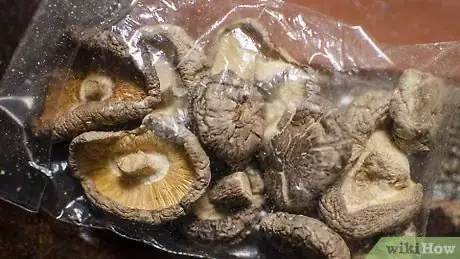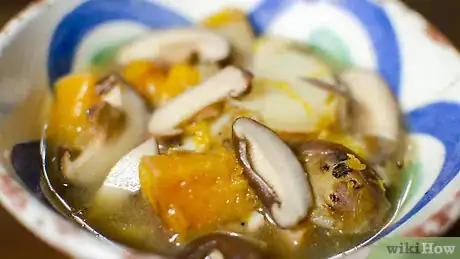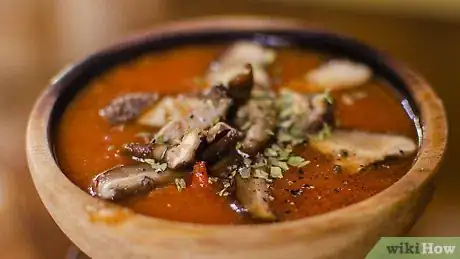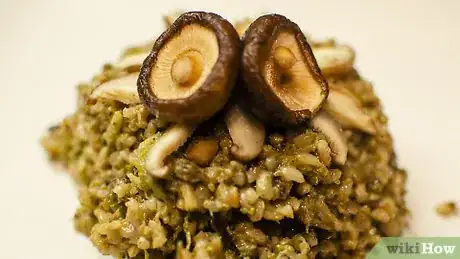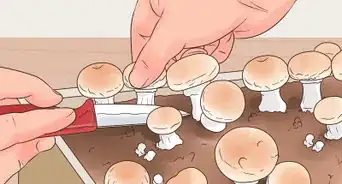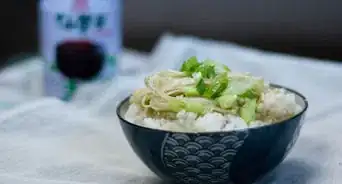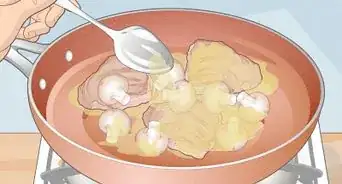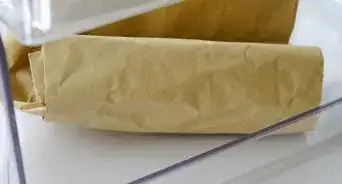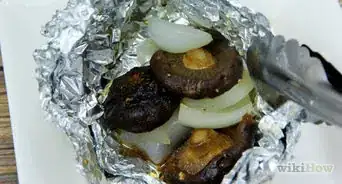This article was co-authored by wikiHow Staff. Our trained team of editors and researchers validate articles for accuracy and comprehensiveness. wikiHow's Content Management Team carefully monitors the work from our editorial staff to ensure that each article is backed by trusted research and meets our high quality standards.
There are 11 references cited in this article, which can be found at the bottom of the page.
The wikiHow Video Team also followed the article's instructions and verified that they work.
This article has been viewed 36,212 times.
Learn more...
Dried mushrooms are prized by many chefs for their long shelf life, bold flavor, and usefulness in a wide variety of recipes. To use dried mushrooms in your favorite dishes, you’ll first need to rinse them thoroughly and soak them in a bowl of water to return them to their original size and texture. You can then use them the way you would any other mushroom, adding them or their flavorful broth to soups, stir frys, sauces, casseroles, or any number of delectable recipes.
Steps
Rehydrating Dried Mushrooms
-
1Shop for the variety of mushrooms you want to cook with. You can find dried mushrooms in the produce section at most supermarkets. There are many different kinds to choose from, including shiitake, morel, porcini, wood ear, and trumpet. Each variety of mushroom has its own distinct flavor profiles and utility in different recipes.[1]
- If you don’t see dried mushroom in the produce section, check the spice aisle. Dried mushrooms are sometimes classified as a flavoring rather than a vegetable.
- Selections like shiitake, matsutake, and cloud ear are commonly used in earthy Asian soups and stir frys, while porcinis, trumpets, and chanterelles are essential ingredients in savory European-style stews and sauces.[2]
-
2Give the mushrooms a quick rinse to remove grit. Portion out the exact amount of mushrooms you plan on cooking and place them in a colander or mesh strainer. Run the mushrooms under a gentle stream of cool water, tossing them every few seconds to loosen and wash away whatever sediment happens to be clinging to the surface.[3]
- Most recipes that call for dried mushrooms specify dry quantities, which makes it easier to measure them out than trying to predict their weight after a short soak.
- When it comes to dried mushrooms, you get what you pay for—cheap, low-quality varieties tend to be far grittier than their finer counterparts.[4]
- Grit is one of the biggest challenges of cooking with dried mushrooms, as it only takes a little bit to throw off the texture of an entire dish.
Advertisement -
3Transfer the dried mushrooms to a spacious bowl. Place the freshly-rinsed mushrooms at the bottom of the bowl. Make sure they’re concentrated near the center so they’ll have plenty of room to expand as they absorb moisture.
- Don’t forget to reseal the package of mushrooms once you’ve portioned and rinsed all you need to prevent moisture from getting in.
-
4Cover the mushrooms with water. Fill the bowl with just enough water to completely submerge the dried mushrooms. Some chefs prefer to use hot water, as they believe it helps the mushrooms regain their original size and texture faster. However, lukewarm or room temperature water will normally be your best bet.[5]
- There’s a chance that hot water could leach flavor out of the mushrooms. For this reason, it may be best reserved for recipes that call for broth rather than the mushrooms themselves.
- Going with hot water can also come in handy when you’re in a hurry and don’t have hours to soak your mushrooms.[6]
-
5Let the mushrooms soak for up to 2 hours. Exact soaking times will vary depending on the type of mushroom you’re working with. Large or thick-cut varieties like shiitakes may need a couple full hours to plump back up, while most other types will be ready to go in just 10-20 minutes. As the mushrooms soak, they’ll gradually begin to take on a soft, meaty texture.[7]
- Keep an eye on the mushrooms and remove them from the water when they stop growing. If you let them sit for too long, they could get mushy and begin to lose some of their flavor.
-
6Save the leftover soaking liquid to use as a flavoring broth. Once your dried mushrooms have been properly rehydrated, pour the excess liquid off into a separate container. It can be used to infuse extra savory or umami notes into soups, stews, sauces, and other preparations.[8]
- If necessary, you can strain your soaking liquid through a coffee filter or piece of cheesecloth to capture any remaining grit.
- If you don’t plan on using your mushroom broth right away, cover the container and stick it in the freezer, where it will keep indefinitely until you’re ready to bring it out.[9]
Using Dried Mushrooms in Various Recipes
-
1Lend flavor to soups and stews. When preparing dishes with liquid bases, you can either use the mushrooms by themselves or add a splash of the leftover broth to turn the taste factor up a notch. The liquid you soak your dried mushrooms in will be highly concentrated, so be careful not to overdo it.[10]
- Dried mushrooms are staples of dishes like wild mushroom soup, minestrone, and goulash, as well as Japanese soups like miso and ramen.
- If you’re not a fan of mushrooms but the recipe you’re putting together calls for them, try substituting a couple ounces of mushroom broth instead.[11]
-
2Enhance your favorite sauces. The next time you’re heating up a rich pasta sauce or pour-over, stir in a handful of dried porcini or trumpet mushrooms. You might be surprised how much dimension they add, even to premade bottled sauces.[12]
- The earthy bite of dried mushrooms is perfect for lending some dimension to tangy tomato sauces, smooth, cream-based concoctions and rich gravies alike.
-
3Incorporate dried mushrooms into sizzling stir frys. Toss your shiitake, wood ear, or other traditional Asian mushrooms with rice, meat, vegetables, and a savory sauce for easy one-pan cooking. If you like, you can even drizzle in a little broth to amplify the mushroom flavor.[13]
- Mushrooms tend to shrink quite a bit under intense heat, so you may need to use more than the amount listed if you want the proportions of your different ingredients to come out just right.
- Firm, filling mushrooms are substantial enough to serve as an alternative to meat in vegetarian and vegan dishes.[14]
-
4Add dried mushrooms to eggs. Cut the mushrooms into chunks or thin slivers, then whisk them into a pan full of scrambled eggs or fold them into an omelette. Tender, buttery chanterelles are especially good for this purpose. Pair with other veggies like onion, spinach, tomatoes, and bell peppers.[15]
- Try working dried mushrooms into other egg-heavy offerings like frittatas and quiche, as well.
-
5Make some homemade herbed butter. Combine any variety of dried mushrooms with softened butter and zesty herbs in a food processor and pulse them until they’re thoroughly blended. Spoon the mixture into a separate container and refrigerate it until it hardens.[16]
- Use your herbed butter on grilled meats and veggies, or fresh seafood, or hearty multigrain bread.[17]
- Herbed butter can also be used in place of regular butter in vegetable dishes like mashed potatoes and creamed spinach.
Things You’ll Need
- Packaged dried mushrooms
- Large bowl
- Water
- Colander or mesh strainer
- Separate container for storing broth
- Assorted cookware
References
- ↑ https://www.seriouseats.com/2015/06/mushroom-shopping-guide.html
- ↑ https://www.thekitchn.com/how-to-work-with-dried-mushrooms-cooking-lessons-from-the-kitchn-196980
- ↑ https://www.thespruceeats.com/how-to-rehydrate-chinese-dried-mushrooms-p2-4110249
- ↑ https://www.thekitchn.com/how-to-work-with-dried-mushrooms-cooking-lessons-from-the-kitchn-196980
- ↑ https://www.thekitchn.com/how-to-work-with-dried-mushrooms-cooking-lessons-from-the-kitchn-196980
- ↑ https://www.thespruceeats.com/how-to-rehydrate-chinese-dried-mushrooms-p2-4110249
- ↑ https://food52.com/blog/19725-a-tip-for-making-dried-mushrooms-silkier-plumper
- ↑ https://www.thespruceeats.com/how-to-rehydrate-chinese-dried-mushrooms-p2-4110249
- ↑ https://www.thekitchn.com/how-to-work-with-dried-mushrooms-cooking-lessons-from-the-kitchn-196980
- ↑ https://www.finecooking.com/article/the-bold-flavors-of-dried-mushrooms
- ↑ https://www.foodnetwork.com/recipes/tyler-florence/hearty-shiitake-mushroom-and-miso-soup-recipe-1942676
- ↑ https://www.bonappetit.com/recipe/tortellini-with-porcini-mushroom-sauce
- ↑ https://www.thespruceeats.com/how-to-rehydrate-chinese-dried-mushrooms-p2-4110249
- ↑ https://cooking.nytimes.com/recipes/1014348-mushroom-stir-fry
- ↑ https://www.finecooking.com/article/the-bold-flavors-of-dried-mushrooms
- ↑ https://www.thechunkychef.com/pan-seared-steak-with-porcini-and-herb-butter/
- ↑ https://www.thespruceeats.com/herb-butter-recipe-1327883
- ↑ https://www.bonappetit.com/story/how-to-rehydrate-dried-mushrooms
